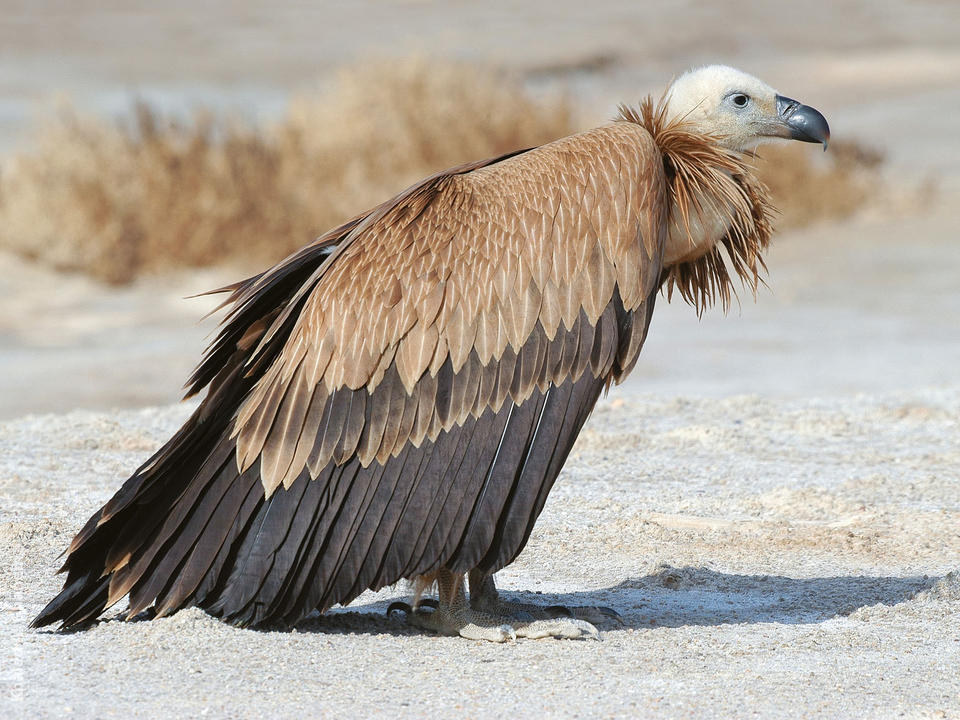Indian Vulture Bird Details
Gyps indicus
Indian Vulture,Long-billed vulture, Indian White-backed Vulture;
Jatayu
Giovanni Antonio Scopoli, 1786
Accipitriformes (HAWKS, EAGLES and KITES)
Accipitridae
Gyps
India, Nepal, Bhutan, Bangladesh, and Pakistan.
Appearance :
The Indian Vulture has a distinctive appearance with a predominantly white to pale grey body, a white back with a rufous or brownish tint, and a characteristic bare head and neck which are usually pinkish or pale. It has a broad wingspan and a short, stout beak.
Behaviour :
These vultures are social birds, often seen in large groups around carcasses. They are scavengers and play a crucial role in the ecosystem by cleaning up dead animals.
Habitat :
Indian Vultures prefer open and semi-open landscapes such as grasslands, savannahs, and scrublands. They are often found near areas where large ungulates or other prey might die.
Diet :
Their diet consists primarily of carrion. They feed on the remains of dead animals, which they locate using their keen eyesight.
Conservation Status :
Critically Endangered
Distribution :
The Indian Vulture is native to the Indian subcontinent, including India, Nepal, Bhutan, Bangladesh, and Pakistan.
Population Size :
5000 to 15000 birds in the wild.
Life Span :
Indian vultures have a lifespan of 40 to 45 years
Body And Tarsus:
- Body: Large, powerful scavenger with a robust and muscular build.
- Tarsus Length: Approximately 8-9 cm (3.1-3.5 inches).
Head And Bill :
- Head: The head is small relative to the body, with a bare, wrinkled skin that is typically pinkish or pale in color.
- Bill: Strong, hooked, and robust, designed for tearing flesh.
- Bill Length: Around 4-5 cm (1.6-2 inches).
Length :
Approximately 70-90 cm (28-35 inches) from beak to tail.
Neck :
Long and slender, covered with sparse feathers. The bare neck helps in thermoregulation and feeding.
Size :
Large-sized vulture, with a robust build and significant wingspan.
Tail Details :
- Tail: Short and broad compared to other raptors, giving it a characteristic appearance in flight.
- Tail Length: About 20-25 cm (8-10 inches).
Weight :
Males weigh between 4-6 kg (8.8-13.2 lbs), and females are slightly heavier, weighing between 5-7 kg (11-15.4 lbs).
Wing :
Broad and long with a rounded or slightly concave leading edge, suited for soaring.
Wing Span :
Approximately 2.3-2.7 meters (7.5-8.9 feet).
Facial Feature :
The Indian Vulture has a bare head with wrinkled skin, which is pale or pinkish, and a small, hooked bill.
Nest Details :
- Nest: The nest is usually large and bulky, made of sticks, twigs, and other materials. It is often built on cliffs, in tall trees, or on man-made structures like buildings or power towers.
- Nest Materials: The nest is constructed from sticks, branches, and other plant materials. It may also include dung and other debris.
Breeding Season :
Typically occurs from December to May.
Nesting Season :
The nesting season aligns with the breeding period, from late winter to early summer.
Egg Color :
The eggs are typically pale or white, sometimes with speckles or spots.
Egg Length :
Approximately 7.5-8.5 cm (3-3.3 inches).
Egg Width and Weight :
- Egg Width: About 5.5-6 cm (2.2-2.4 inches).
- Egg Weight: Around 160-180 grams (5.6-6.3 ounces) per egg.
Clutch Size :
Usually 1-2 eggs per clutch.
No. of Broods :
Generally, the Indian Vulture raises one brood per year.
Incubation Period :
Approximately 50-55 days.
Nestling Period :
The chicks fledge after about 80-90 days of nesting.
Vocalization :
The vocalizations are usually harsh and rasping. They include various grunts and calls that are used during communication between adults and in social interactions.
Sex Demorphism :
There is little visible sexual dimorphism between males and females, though females are generally slightly larger and heavier than males.
Migration Details :
The Indian Vulture is a resident species and does not migrate.







